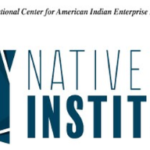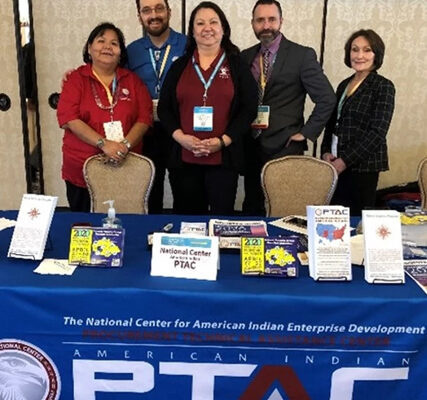George Williams Celebrates 20 Years with the National Center’s PTAC
George Williams, Program Manager at the National Center’s American Indian Procurement
Technical Assistance Center (AIPTAC), recently marked his 20th year working to grow and develop Native-owned businesses. Starting at the AIPTAC in 2000, George has seen the federal contracting space change firsthand, from payphones, calling cards, and “brick” cell phones to now handling cybersecurity requirements from the Department of Defense. George has seen the industry transform, and throughout that time has helped businesses of all shapes and sizes realize the federal opportunities and programs available to them. In one instance, George helped Wells Technology grow their revenues from $900,000 to $88 million – in only six years!
The National Center and the Native-owned businesses we support are lucky to have George’s experience and passion for the job over the last 20 years. We hope you enjoy learning more about George and his work at the AIPTAC!
Tell us a little bit about yourself?
I was born and raised in Marietta, Georgia. My Father worked at Lockheed Martin as a Mechanical Engineer from 1950 – 1986, which was Lockheed at the time and later merged with Martin Marietta to become Lockheed Martin. I grew up with a love of military aircraft, but due to vision problems, I found out I could not fly, so I decided not to enter the Armed Services. Still intrigued by military aircraft, I followed in my Father’s footsteps and went to work for Lockheed Martin in June of 1984. While there, my Father and I received a “Buck Hunter” Cost Savings Award for our work on the design of a power tool that was projected to save over $500K on the C-5B Program. Standing beside him on the assembly jig he designed and using the power tool we designed together for our cover picture on the “Lockheed Star” company newspaper was one of the proudest moments of my life. I later moved from aircraft production into purchasing.
How did you first get started working at the American Indian Procurement Technical Assistance Center (AIPTAC)? What were those early years like?
About 5 years after the merger between Lockheed and Martin Marietta, functions were being consolidated across the organization, including purchasing. My purchasing commodities were transferred to the Lockheed Martin’s Ft. Worth Division and I was given a 60-Day WARN Notice that I was to be laid off. However, I read in the Lockheed Star company newspaper that the National Center was opening an East Coast American Indian PTAC (Procurement Technical Assistance Center) Office. So, when the National Center Vice President at the time, David Beaver, came out to visit the office, I asked him for a job.
When I began working for the National Center back in November of 2000, the federal government was in the process of transitioning from written hard files into web-based information. Commerce Business Daily would mail procurement notices, solicitations, drawings, and amendments. We were still using land lines, dial up internet, and the U.S. Mail. When I traveled, I had to use a Rand McNally Atlas to find my way around and a calling card that I used at payphones or hotel phones for all my long-distance phone calls. Needless to say, I got lost a lot! I didn’t have a cell phone when I became a Program Manager in 2006, but because it was required for the position, I bought a Panasonic “brick” telephone at a pawn shop because the National Center didn’t provide cell phones at the time. The phone was so antiquated that when I once left it in an airplane by accident, nobody took it!
The first reservation I visited was the Mississippi Choctaw Reservation for our “Eastern Reservation Economic Summit” Conference in July of 2001. I’ll never forget seeing Chief Phillip Martin walking across the field after the stickball competition and introducing myself to him and shaking his hand. Up to that point, I had only seen pictures and watched a video of him. Meeting someone of his status in Indian Country was quite a moment for me. About a month later that year, when I visited the Oneida Nation of Wisconsin, I was given a tour of the reservation by Marge Stevens, Mother of Ernie Stevens of the National Indian Gaming Association (NIGA), who worked for the Oneida Nation at that time. The hospitality shown to me by my hosts at the Mississippi Choctaw Reservation and the Oneida Nation of Wisconsin made a strong initial impression on me and helped foster the love of Indian Country that I have today.
You recently celebrated your 20th anniversary of employment at AIPTAC. Looking back, is there one business or moment that stands out to you as especially rewarding?
An especially rewarding moment was when the AIPTAC received the 2011 Economic Impact Award from the Association of Procurement Technical Assistance Centers for its efforts in assisting Wells Technology, Inc. Wells Technology, Inc. was one of my early clients when I started as a Procurement Specialist. The AIPTAC assisted Wells Technology in growing from 14 employees and gross sales revenues of $900,000 in 2004 to 49 employees and gross sales revenues of $88,042,000 in 2010. In addition to the economic impact, what makes this especially rewarding is that a portion of Wells Technology, Inc. profits are used to fund Wells Academy, a non-profit organization that trains Native youth and at risk individuals to become high tech machinists.
How have you seen the landscape for federal contracting for Native American businesses change over the years you’ve spent at AIPTAC?
The adoption of the internet and internet-based systems by government is one of the greatest changes. All payments are now done via electronic funds transfer. The necessity and difficulty in maintaining secure internet access and proper security protocols is something nobody had to worry about 20 years ago. The new Cybersecurity Maturity Model Certification (CMMC) for DOD Contracts is a recent requirement that I am afraid many small businesses haven’t prepared for. The DOD 5% Indian Incentive Program was an underutilized program 20 years ago, often with unused funds being de-obligated at the end of the fiscal year. Thanks to the efforts of the National Center and other Native American organizations over the years, we have seen the DOD 5% Indian Incentive Program annual funding grow from an $8 million to $25 million, with a backlog of rebate requests. Progress has also been made with the utilization of the Buy Indian Act, creating new opportunities for Native American Businesses with the Department of Interior and Indian Health Service.
You’ve amassed 20 years of experience working with Native entrepreneurs and Native-owned businesses of all sizes. What is your number one piece of advice to any person or business looking to get into the federal contracting arena?
Do your homework and research, which includes taking advantage of the many free federally funded resources available to you. Don’t plan your business around the success of other businesses. Your skills and experience are unique. An example is the U.S. Small Business Administration (SBA) 8(a) Program. While the 8(a) Program can limit competition and does allow for sole source contracts, it is only a “license to hunt” and the business owner, not the SBA, is responsible for the success of the business in maximizing the value of its participation in the program. To effectively use the program, a business must have a tried and true marketing plan and capture strategy in place before entering the 8(a) Program. Having a thoroughly vetted and competent subcontracting team is also a huge success multiplier. Being involved in a 9 year business development program, I have encountered a number of businesses that wasted the first half of their program eligibility trying to find a market for their company’s products and services and/or subcontracting team after becoming 8(a) certified.
Anything else you’d like to add?
I’d like to express my gratitude to Lockheed Martin and the National Center for the difference both organizations have made in my life. My Father’s job at Lockheed Martin supported our family and enabled my parents to pay for my college education. Lockheed Martin also provided my start in the aerospace industry and gave me my background in procurement that was necessary for my career to move forward, along with their donation of the East Coast AIPTAC Office.
Finally, I would like to thank the National Center for providing me the opportunity to utilize my past skills and knowledge for the benefit of Indian Country. I have been more places, met more people, and experienced more in life in my career with the National Center than at any other time in my life. We have a great staff at the AIPTAC Office and I appreciate the strong support of the National Center’s AIPTAC by the headquarters staff, President/CEO, and the National Center Board of Directors. I look forward to what the future brings in my continued career with the National Center.











